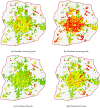Evaluating the Inequality of Medical Service Accessibility Using Smart Card Data
- PMID: 33800216
- PMCID: PMC7967441
- DOI: 10.3390/ijerph18052711
Evaluating the Inequality of Medical Service Accessibility Using Smart Card Data
Abstract
The measurement of medical service accessibility is typically based on driving or Euclidean distance. However, in most non-emergency cases, public transport is the travel mode used by the public to access medical services. Yet, there has been little evaluation of the public transport system-based inequality of medical service accessibility. This work uses massive real smart card data (SCD) and an improved potential model to estimate the public transport-based medical service accessibility in Beijing, China. These real SCD data are used to calculate travel costs in terms of time and distance, and medical service accessibility is estimated using an improved potential model. The spatiotemporal variations and patterns of medical service accessibility are explored, and the results show that it is unevenly spatiotemporally distributed across the study area. For example, medical service accessibility in urban areas is higher than that in suburban areas, accessibility during peak periods is higher than that during off-peak periods, and accessibility on weekends is generally higher than that on weekdays. To explore the association of medical service accessibility with socio-economic factors, the relationship between accessibility and house price is investigated via a spatial econometric analysis. The results show that, at a global level, house price is positively correlated with medical service accessibility. In particular, the medical service accessibility of a higher-priced spatial housing unit is lower than that of its neighboring spatial units, owing to the positive spatial spillover effect of house price. This work sheds new light on the inequality of medical service accessibility from the perspective of public transport, which may benefit urban policymakers and planners.
Keywords: accessibility; inequality; medical service; smart card data.
Conflict of interest statement
The authors declare no conflict of interest.
Figures












Similar articles
-
Inferring transit-based health seeking patterns from smart card data - A case study in Beijing, China.Health Place. 2020 Sep;65:102405. doi: 10.1016/j.healthplace.2020.102405. Epub 2020 Aug 19. Health Place. 2020. PMID: 32827938
-
Unequable spatial accessibility to hospitals in developing megacities: New evidence from Beijing.Health Place. 2020 Sep;65:102406. doi: 10.1016/j.healthplace.2020.102406. Epub 2020 Aug 30. Health Place. 2020. PMID: 32877867 Free PMC article.
-
Equity in Health-Seeking Behavior of Groups Using Different Transportations.Int J Environ Res Public Health. 2022 Feb 27;19(5):2765. doi: 10.3390/ijerph19052765. Int J Environ Res Public Health. 2022. PMID: 35270458 Free PMC article.
-
Facility or Transport Inequality? Decomposing Healthcare Accessibility Inequality in Shenzhen, China.Int J Environ Res Public Health. 2022 Jun 4;19(11):6897. doi: 10.3390/ijerph19116897. Int J Environ Res Public Health. 2022. PMID: 35682478 Free PMC article.
-
The application of spatial measures to analyse health service accessibility in Australia: a systematic review and recommendations for future practice.BMC Health Serv Res. 2023 Apr 1;23(1):330. doi: 10.1186/s12913-023-09342-6. BMC Health Serv Res. 2023. PMID: 37005659 Free PMC article.
Cited by
-
Spatial Accessibility Analysis of Medical Facilities Based on Public Transportation Networks.Int J Environ Res Public Health. 2022 Dec 4;19(23):16224. doi: 10.3390/ijerph192316224. Int J Environ Res Public Health. 2022. PMID: 36498300 Free PMC article.
References
-
- Yin C., He Q., Liu Y., Chen W., Gao Y. Inequality of public health and its role in spatial accessibility to medical facilities in China. Appl. Geogr. 2018;92:50–62. doi: 10.1016/j.apgeog.2018.01.011. - DOI
-
- Cheng G., Zeng X., Duan L., Lu X., Sun H., Jiang T., Li Y. Spatial difference analysis for accessibility to high level hospitals based on travel time in Shenzhen, China. Habitat Int. 2016;53:485–494. doi: 10.1016/j.habitatint.2015.12.023. - DOI
-
- Wang J., Du F., Huang J., Liu Y. Access to hospitals: Potential vs. observed. Cities. 2020;100:102671. doi: 10.1016/j.cities.2020.102671. - DOI
-
- Wang F. Quantitative Methods and Applications in GIS. CRC Press; Boca Raton, FL, USA: 2006.
Publication types
MeSH terms
LinkOut - more resources
Full Text Sources
Other Literature Sources

